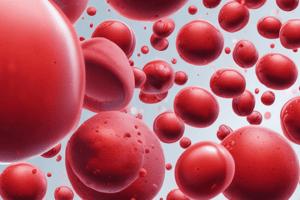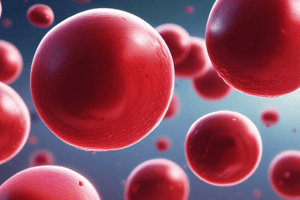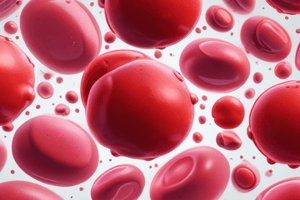Podcast
Questions and Answers
Anaemia is defined as a reduction in Haemoglobin due to a disorder of globin or heme.
Anaemia is defined as a reduction in Haemoglobin due to a disorder of globin or heme.
True (A)
The normal haemoglobin level for men is considered to be less than 12g/dL.
The normal haemoglobin level for men is considered to be less than 12g/dL.
False (B)
Blood cells are generated in the spleen.
Blood cells are generated in the spleen.
False (B)
Aplastic anaemia is one of the types of anaemia mentioned.
Aplastic anaemia is one of the types of anaemia mentioned.
The WHO criteria categorize anaemia based solely on red blood cell count.
The WHO criteria categorize anaemia based solely on red blood cell count.
Anaemia in non-pregnant women is defined as having a haemoglobin level below 12g/dL.
Anaemia in non-pregnant women is defined as having a haemoglobin level below 12g/dL.
Macrocytic anaemia is classified as a type of anaemia that results from a disorder of globin or heme.
Macrocytic anaemia is classified as a type of anaemia that results from a disorder of globin or heme.
The bone marrow is responsible for the production of blood cells.
The bone marrow is responsible for the production of blood cells.
The WHO defines anaemia exclusively by the concentration of haemoglobin in the blood.
The WHO defines anaemia exclusively by the concentration of haemoglobin in the blood.
Folate deficiency is not included among the types of anaemia discussed in the lecture.
Folate deficiency is not included among the types of anaemia discussed in the lecture.
Anaemia occurs when the capacity of red blood cells to carry oxygen is sufficient to meet physiological needs.
Anaemia occurs when the capacity of red blood cells to carry oxygen is sufficient to meet physiological needs.
The WHO defines anaemia using specific haemoglobin levels relative to various demographic factors.
The WHO defines anaemia using specific haemoglobin levels relative to various demographic factors.
Aplastic anaemia is classified solely as a haemolytic type of anaemia.
Aplastic anaemia is classified solely as a haemolytic type of anaemia.
Macrocytic and microcytic anaemias are classified based on the types of nutrients deficiencies and not solely by red blood cell size.
Macrocytic and microcytic anaemias are classified based on the types of nutrients deficiencies and not solely by red blood cell size.
A haemoglobin level lower than 13g/dL is considered a definition of anaemia for non-pregnant women.
A haemoglobin level lower than 13g/dL is considered a definition of anaemia for non-pregnant women.
Anaemia can occur when the oxygen-carrying capacity of red blood cells meets physiological needs.
Anaemia can occur when the oxygen-carrying capacity of red blood cells meets physiological needs.
The WHO considers a haemoglobin level of 12g/dL or higher to be normal for non-pregnant women.
The WHO considers a haemoglobin level of 12g/dL or higher to be normal for non-pregnant women.
Anaemias can be classified based on specific nutrient deficiencies and red blood cell size.
Anaemias can be classified based on specific nutrient deficiencies and red blood cell size.
Aplastic anaemia is categorized as a type of haemolytic anaemia.
Aplastic anaemia is categorized as a type of haemolytic anaemia.
Blood cells in the human body are primarily generated in the liver.
Blood cells in the human body are primarily generated in the liver.
Flashcards are hidden until you start studying
Study Notes
Anaemia Definition
- Anaemia is a condition with insufficient red blood cells or oxygen-carrying capacity to meet physiological needs.
- Physiological needs vary by age, sex, altitude, pregnancy status and smoking.
- The WHO criteria for anaemia is Haemoglobin < 12g/dL in non-pregnant women & Haemoglobin < 13g/dL in men.
Blood Production
- Blood is made in the bone marrow.
Anaemia Types
- This lecture outlines types of anaemia other than haemolytic anaemia.
- Categories:
- Iron deficiency anaemia
- Vitamin B12 deficiency anaemia
- Folate deficiency anaemia
- Aplastic anaemia
Anaemia Pathophysiology
- Anaemia is a reduction in Haemoglobin due to a disorder of globin or heme.
Introduction
- Anaemia is a condition resulting from a reduction in hemoglobin (Hb) levels.
- Hb levels are reduced due to a disorder of either globin or heme.
- Haemoglobin levels are lower in women than in men: 12 g/dL in women and 13 g/dL in men.
Bone Marrow
- Blood is produced in the bone marrow.
Anaemia
- Anaemia occurs when there are insufficient red blood cells or insufficient oxygen-carrying capacity to meet the body's metabolic needs.
- Physiological needs vary based on age, sex, altitude, smoking, and pregnancy status.
- The World Health Organisation (WHO) criteria for anaemia considers Hb levels below 12 g/dL in women and below 13 g/dL in men as anaemic.
Definition of Anaemia
- Anaemia is a condition where the number of red blood cells or their oxygen-carrying capacity is insufficient to meet physiological needs.
- Physiological needs vary by age, sex, altitude, smoking, and pregnancy status.
- The WHO criteria for anaemia is Haemoglobin levels < 12g/dL in non-pregnant women and < 13g/dL in men.
Blood is Made in the Bone Marrow
- The bone marrow is the site of blood cell generation.
Generation of Blood Cells
- The bone marrow is responsible for the generation of all blood cells.
Anaemia
- Anaemia is a condition that can result from various causes, including iron deficiency, vitamin B12 deficiency, folate deficiency, and aplastic anaemia.
Anaemia Definition
- Anaemia is a condition where red blood cells or their oxygen-carrying capacity is insufficient to meet the body's needs.
- This can be due to a disorder involving the globin or heme components of haemoglobin.
Haemoglobin Levels
- Anaemia is defined as a haemoglobin level below 12g/dL in non-pregnant women.
- A haemoglobin level below 13g/dL in men is considered anaemia.
Blood Production
- Blood is produced in the bone marrow.
Anaemia Causes
- Anaemia can arise from various conditions, including:
- Iron deficiency
- Vitamin B12 deficiency
- Folate deficiency
- Aplastic anaemia
- The lecture focuses on types of anaemia other than haemolytic anaemia.
Studying That Suits You
Use AI to generate personalized quizzes and flashcards to suit your learning preferences.




